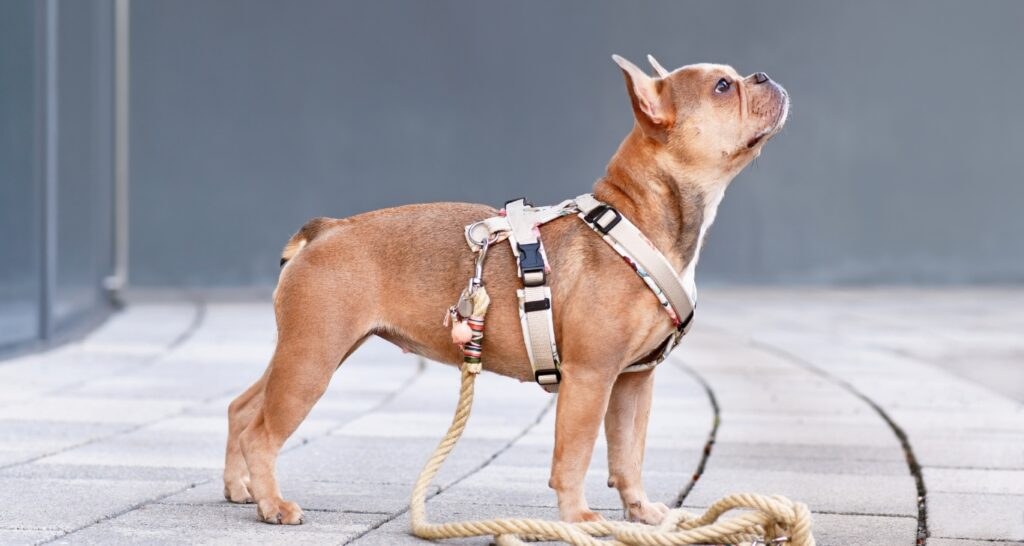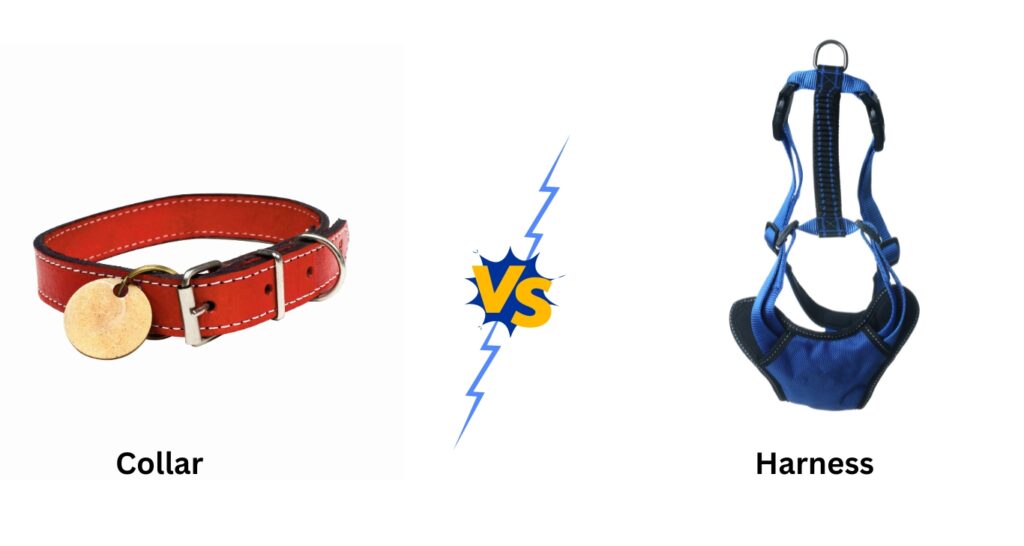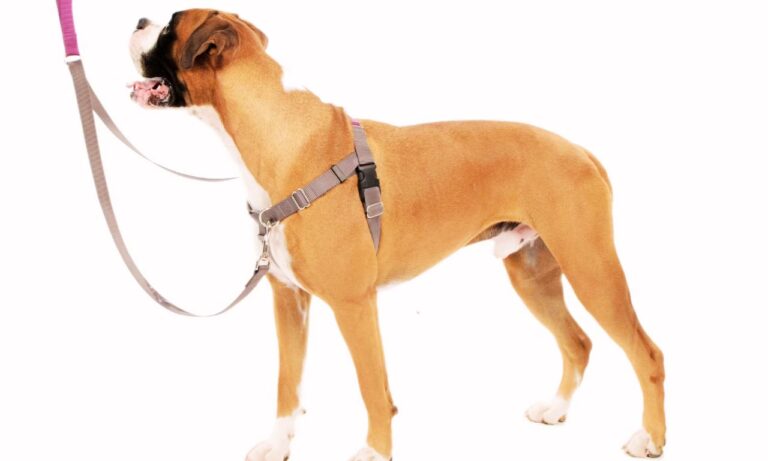Deciding which harness or collar to use when walking your dog is determined by its size, breed, health, and behavior. Both options have strengths and weaknesses, so it is important to know what will suit your pet best. You might want to ask a question, “Is a harness or collar better for dog walking?” This guide will compare and contrast harnesses and collars so that you can easily make a decision on which to buy. Explore the best dog collars for walking that offer comfort, durability, and control, making every walk enjoyable and safe for both you and your dog.
Blog Highlights
ToggleWhat Are Dog Collars?
Dog collars are conventional accessories for many pet owners. They can be worn all day long and allow for the easy addition of ID tags, rabies certificates, and other leash clips.

Pros of Dog Collars:
- Convenience: Collars are very convenient; your dog can wear them for a long time, which is good for trained dogs not pulling on the leash.
- Identification: Collars are usually accustomed to placing ID tags, so if your dog disappears, it can easily be recognized and returned to you.
- Variety: Collars come in diverse styles, materials, and colors; depending on your pet’s personality, you can make your pet an example.
Cons of Dog Collars:
- Risk of Injury: Collars can put pressure on the dog’s neck, which may lead to injury to the tracheal or thyroid part of the neck in case the dog pulls on the leash.
- Limited Control: Collars give out less leverage on the dog, making it hard to manage a dog that likes to tug or is stubborn.
Dog collars can be suitable for properly trained dogs that do not tension the leash and are not bothered by having the collar on all day. However, they are not ideal for dogs that pull their owners when walking or for dogs with neck or breathing problems. Get prepared with helpful advice on bringing home a Great Dane puppy, including essential preparations and training tips.
What Are Dog Harnesses?
Many people use harnesses with their pets, especially energetic or stubborn ones. Harnesses spread force all over a dog’s body and are safer tools for dogs to wear when walking.

Pros of Dog Harnesses:
- Improved Control: Collars, which include choke collars, are useful in restraining dogs, especially those that pull or those that are stubborn. A harness helps to spread pull over the chest and shoulders rather than the neck; it prevents choking or snapping of the neck.
- Safety for Small and Fragile Dogs: Harnesses are recommended for small breeds, puppies, or dogs with breathing complications, as they don’t exert force on the tracheal and neck muscles, unlike a collar. Harnesses are also good for dogs with neck and spine problems or who have had surgery on their necks.
- Training Aid: Some of the advantages of using harnesses include that they can be used on puppies or dogs that do not have experience with the leash. Front-clip harnesses help prevent this action by turning the dog towards the handler, thus making walks less stressful.
Cons of Dog Harnesses:
- Complexity: Collars are less easy to remove or put on, and this can sometimes be a bother, especially when the dogs are very much in motion.
- Heat Retention: However, some may be uncomfortable, especially during hot weather, because they cover a larger part of the dog’s body.
- Limited ID Tag Space: Some harnesses lack a location where ID tags could fit; thus, you may need to put a collar along with the harness for identification purposes.
In particular, harnesses are used by dog owners who observe undesirable behaviors such as pulling on the leash, health problems, or an increased need for maneuverability during the walk. Harnesses have a number of safety advantages, but they come with fitting issues and cannot be applied universally. Understand why a Great Dane can make an excellent family dog with insights into their temperament and adaptability.
Which Dogs Should Use a Collar?
Collars are good for some dogs as they provide the right amount of control plus the comfort of the dog and the owner. To several people, it may be easier to control the movements of a small to medium-sized dog during walks than a collar since less strain is exerted on the owner’s body.
Collars are also suitable for puppies trained to walk on a leash. Some of the most recommended items that dog trainers suggest using include a standard 4-foot leash and a flat collar because they are useful in forming the dog’s walking manners without inducing stress.

1. Wide Styles
Another benefit of using collars is that there are many styles and options for the type of material the collar is made of. Depending on your preference, you can choose nylon, leather, or any other type of collar.
These types of collars are easy to fix on and remove, do not cause much discomfort to the pet, and are quite durable. Also, there are collars that have quick-release buckles or adjustable sizes and, therefore, can be used regularly.
2. Not Attended for Greyhounds and Whippets.
But one must understand that collars are not the perfect solution for every dog. For instance, Greyhounds and Whippets with smaller heads than their necks are liable to escape from a collar that has not been fitted correctly.
If a dog pulls a lot on the leash, a collar can put pressure on the neck area. In such cases, a harness may be a safer and more comfortable way of climbing. Check out the best options for dog collars for Great Danes that offer both strength and comfort for these large breeds.
Which Dogs Should Use a Harness?
For many dogs, especially pullers and those with certain health issues, dog harnesses can be quite useful. Collars, on the other hand, provide less control over the dog’s body as pressure is exerted on the dog’s neck, while harnesses provide control over the dog’s entire body.
This can be especially helpful for large or muscular dogs so they don’t choke or place too much pressure on their necks. They can also prevent a leash from getting tangled beneath a dog’s legs, thereby enhancing smooth walks.

1. Perfect for Pull-Prone Dogs
For those dogs that tend to pull or lunge, a harness can be an effective tool in stopping this as it gives the dog less room to move and gain forward motion. It is also suggested for small dogs or those with breathing problems; it helps prevent throat damage or worsen back pain. They are also suitable for senior dogs or those that have been operated on since they do not force the neck more than it can take.
2. Need Strength to Set Up
However, harnesses also have some disadvantages. These types of collars are usually harder to put on and take off than collars and may also require the owner to exercise more force when controlling large breeds of dogs. Also, there are some drawbacks to a wrong-fit harness.
If it is too loose, the dog can slip out of it and escape, while if it is too tight, it may cause the dog discomfort or even pain, especially in hot weather. Just as with collars, you need to ensure that the harness fits your dog well so that he or she can be comfortable and safe. Learn whether it’s safe for a dog to swim with an e-collar, including safety tips and recommendations.
Comparing Collars and Harnesses: Which is Better?
So, Is a harness or collar better for dog walking? Choosing between a collar or a harness for your dog involves considering which one is best for your dog, given its temperance and characteristics.

1. For Small Dogs and Puppies:
A harness is usually suitable for small breeds and puppies. It protects delicate neck structures, offers better control, and can help avoid exerting force on the dog during training.
2. For Large or Strong Dogs:
Large dogs, particularly those that pull hard, benefit from being restrained without causing injury to the owner or the dog. A front-clip harness can help eliminate pulling by redirecting the dog’s focus back to the handler, making walks more enjoyable.
3. For Well-Trained Dogs:
You can use a collar, especially if your dog is well trained, calm, and does not pull a leash. Collars are easier to use, can be kept on the dog for continuous periods during the day, and have a place to attach tags.
4. For Dogs with Health Issues:
Dogs with neck issues, such as injuries, back problems, or respiratory difficulties, such as dogs with collapsing trachea, will derive more benefit than other dogs when using a harness that does not apply pressure on the neck and provides more control during walking. Find out if shock collars are effective in water, and learn about their functionality and potential limitations when wet.
Comparison Table: Collar Vs. Harness
Final Recommendation: Harness and Collar Together?
Although harnesses provide more safety and control as compared to collars, particularly for pulling dogs, most owners believe that using both harnesses and collars would provide the best of everything. ID tags help identify the dog in case it gets lost, and a collar with a leash offers safety during walks for both the dog and the handler. This way, you will be able to handle walks well while at the same time ensuring that your dog is safe and comfortable.
Wrapping Up!
It is impossible to state that a harness or a collar is better for dog walking since it depends on various factors. Ensure that you take your dog’s size, breed, behavior, and any health concerns that it might have into consideration when making your decision. Discover the top picks for dog collars suitable for swimming that are designed to handle water exposure while keeping your pet comfortable.
In other cases, a collar may pose an ideal solution, while others require a harness for extra control and security. In conclusion, it is possible to state that the best option is the one that fits your dog’s requirements and avoids any discomfort and possible risks during a walk. Hope so, now your question is answered: “Is a harness or collar better for dog walking?”





